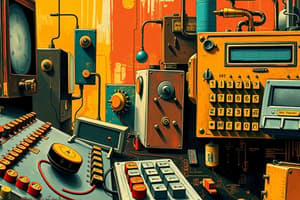Podcast
Questions and Answers
Which computer was the first to have storage capability for both data and instructions?
Which computer was the first to have storage capability for both data and instructions?
- UNIVAC
- EDSAC (correct)
- ENIAC
- MARK-1
What unique technology did the ENIAC primarily utilize for its operations?
What unique technology did the ENIAC primarily utilize for its operations?
- Solid-state transistors
- Magnetic tapes
- Mercury delay lines
- Vacuum tubes (correct)
What was the main application area for the UNIVAC computer?
What was the main application area for the UNIVAC computer?
- Military calculations
- Weather prediction
- Scientific research
- Business applications (correct)
Which computer was specifically designed by Howard Aiken and utilized interlocking panels?
Which computer was specifically designed by Howard Aiken and utilized interlocking panels?
What distinguishing feature did the IBM-650 Computer have regarding input and output?
What distinguishing feature did the IBM-650 Computer have regarding input and output?
What was the primary application of the Abacus?
What was the primary application of the Abacus?
Which invention was specifically designed for the automation of weaving?
Which invention was specifically designed for the automation of weaving?
What key characteristic distinguishes Napier’s Bones from other calculating devices?
What key characteristic distinguishes Napier’s Bones from other calculating devices?
Which invention is referred to as the first general-purpose computer?
Which invention is referred to as the first general-purpose computer?
Who invented the Pascaline, the first mechanical adding machine?
Who invented the Pascaline, the first mechanical adding machine?
What type of operations could the Tabulating Machine perform?
What type of operations could the Tabulating Machine perform?
What was a significant technological feature of Jacquard’s Loom?
What was a significant technological feature of Jacquard’s Loom?
Which invention was primarily used for multiplication of large numbers?
Which invention was primarily used for multiplication of large numbers?
Flashcards
MARK-1
MARK-1
Early electromechanical computer, using mechanical components instead of electronic ones, for calculations. Built in 1944 by Howard Aiken.
ENIAC
ENIAC
First electronic general-purpose computer using vacuum tubes. Created in 1946 by J.P. Eckert and J.W. Mauchly, used for calculations.
EDSAC
EDSAC
First computer to store both data and instructions. Designed in 1949 by John von Neumann
UNIVAC
UNIVAC
Signup and view all the flashcards
IBM-650
IBM-650
Signup and view all the flashcards
Abacus (1602)
Abacus (1602)
Signup and view all the flashcards
Napier's Bones (1617)
Napier's Bones (1617)
Signup and view all the flashcards
Pascaline (1642)
Pascaline (1642)
Signup and view all the flashcards
Jacquard Loom (1801)
Jacquard Loom (1801)
Signup and view all the flashcards
Analytical Engine (1837)
Analytical Engine (1837)
Signup and view all the flashcards
Tabulating Machine (1890)
Tabulating Machine (1890)
Signup and view all the flashcards
Key advancements in computer history
Key advancements in computer history
Signup and view all the flashcards
Early computing devices
Early computing devices
Signup and view all the flashcards
Study Notes
Early Computing Devices
- The abacus, invented in China around 1602, was the first mechanical calculating device.
- Napier's Bones, from 1617, used a three-dimensional structure for multiplication.
- Pascaline, invented in 1642 by Blaise Pascal, was the first mechanical adding machine, used for basic arithmetic.
Key Inventions in Computer History
- Jacquard's Loom (1801): Used punched cards to automate textile weaving. This paved the way for using structured data to control machinery.
- Analytical Engine (1837), Charles Babbage: A first conceptual general-purpose computer, designed but never fully built. It stored programs on pegs.
- Tabulating Machine (1890), Herman Hollerith: First electromechanical machine for larger-scale data processing like the US Census. Used punched cards.
- MARK-1 (1944), Howard Aiken: Used magnetic drums for storage and was used for military and scientific calculations during WWII.
- ENIAC (1946), J.P. Eckert and J.W. Mauchly: First electronic digital computer, using vacuum tubes for logic and capable of complex calculations.
- EDSAC (1949), John Von Neumann: First computer with the ability to store both data and instructions, using mercury delay lines and vacuum tubes.
- UNIVAC (1951), J. Presper Eckert and John Mauchly: First general-purpose electronic computer for business use, using magnetic tapes for input/output.
- IBM-650 Computer (1953), IBM: A general-purpose computer for business, science, and engineering, that featured special characters to decimal conversions and data input/output units.
Fundamental Computer Characteristics
- Automation: Computers can perform tasks without human intervention.
Studying That Suits You
Use AI to generate personalized quizzes and flashcards to suit your learning preferences.



